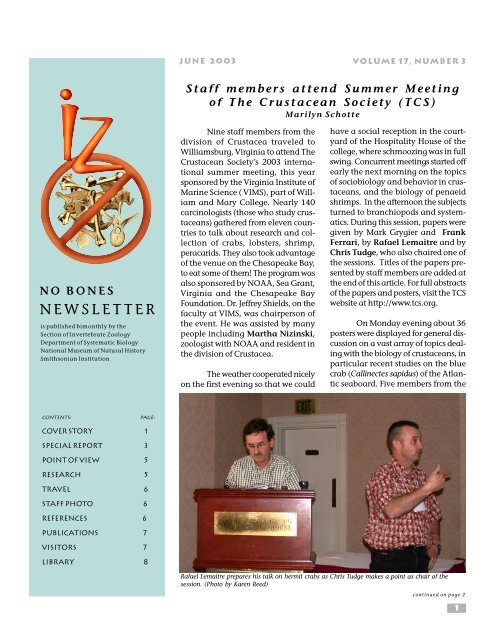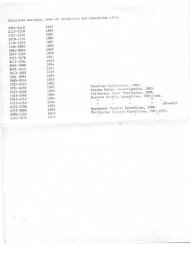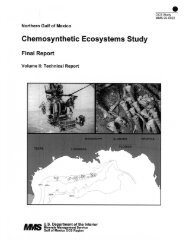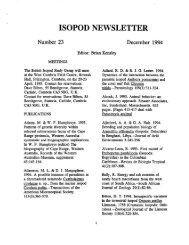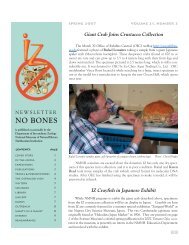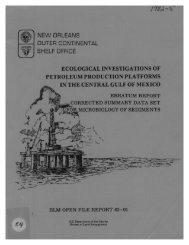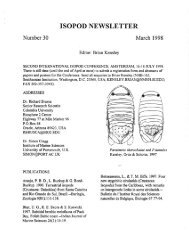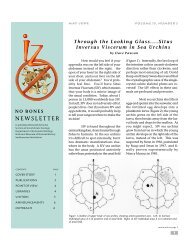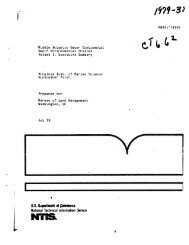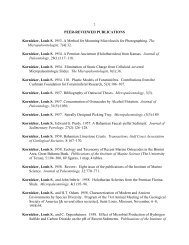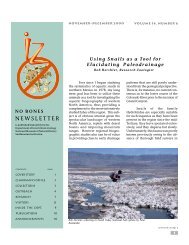June 2003 - Department of Invertebrate Zoology - Smithsonian ...
June 2003 - Department of Invertebrate Zoology - Smithsonian ...
June 2003 - Department of Invertebrate Zoology - Smithsonian ...
Create successful ePaper yourself
Turn your PDF publications into a flip-book with our unique Google optimized e-Paper software.
JUNE <strong>2003</strong><br />
VOLUME 17, NUMBER 3<br />
Staff members attend Summer Meeting<br />
<strong>of</strong> The Crustacean Society (TCS)<br />
Marilyn Schotte<br />
NO BONES<br />
NEWSLETTER<br />
is published bimonthly by the<br />
Section <strong>of</strong> <strong>Invertebrate</strong> <strong>Zoology</strong><br />
<strong>Department</strong> <strong>of</strong> Systematic Biology<br />
National Museum <strong>of</strong> Natural History<br />
<strong>Smithsonian</strong> Institution<br />
Nine staff members from the<br />
division <strong>of</strong> Crustacea traveled to<br />
Williamsburg, Virginia to attend The<br />
Crustacean Society’s <strong>2003</strong> international<br />
summer meeting, this year<br />
sponsored by the Virginia Institute <strong>of</strong><br />
Marine Science ( VIMS), part <strong>of</strong> William<br />
and Mary College. Nearly 140<br />
carcinologists (those who study crustaceans)<br />
gathered from eleven countries<br />
to talk about research and collection<br />
<strong>of</strong> crabs, lobsters, shrimp,<br />
peracarids. They also took advantage<br />
<strong>of</strong> the venue on the Chesapeake Bay,<br />
to eat some <strong>of</strong> them! The program was<br />
also sponsored by NOAA, Sea Grant,<br />
Virginia and the Chesapeake Bay<br />
Foundation. Dr. Jeffrey Shields, on the<br />
faculty at VIMS, was chairperson <strong>of</strong><br />
the event. He was assisted by many<br />
people including Martha Nizinski,<br />
zoologist with NOAA and resident in<br />
the division <strong>of</strong> Crustacea.<br />
The weather cooperated nicely<br />
on the first evening so that we could<br />
have a social reception in the courtyard<br />
<strong>of</strong> the Hospitality House <strong>of</strong> the<br />
college, where schmoozing was in full<br />
swing. Concurrent meetings started <strong>of</strong>f<br />
early the next morning on the topics<br />
<strong>of</strong> sociobiology and behavior in crustaceans,<br />
and the biology <strong>of</strong> penaeid<br />
shrimps. In the afternoon the subjects<br />
turned to branchiopods and systematics.<br />
During this session, papers were<br />
given by Mark Grygier and Frank<br />
Ferrari, by Rafael Lemaitre and by<br />
Chris Tudge, who also chaired one <strong>of</strong><br />
the sessions. Titles <strong>of</strong> the papers presented<br />
by staff members are added at<br />
the end <strong>of</strong> this article. For full abstracts<br />
<strong>of</strong> the papers and posters, visit the TCS<br />
website at http://www.tcs.org.<br />
On Monday evening about 36<br />
posters were displayed for general discussion<br />
on a vast array <strong>of</strong> topics dealing<br />
with the biology <strong>of</strong> crustaceans, in<br />
particular recent studies on the blue<br />
crab (Callinectes sapidus) <strong>of</strong> the Atlantic<br />
seaboard. Five members from the<br />
Contents: Page:<br />
Cover Story 1<br />
special report 3<br />
point <strong>of</strong> view 5<br />
Research 5<br />
travel 6<br />
Staff photo 6<br />
References 6<br />
publications 7<br />
Visitors 7<br />
Library 8<br />
Rafael Lemaitre prepares his talk on hermit crabs as Chris Tudge makes a point as chair <strong>of</strong> the<br />
session. (Photo by Karen Reed)<br />
continued on page 2<br />
1
JUNE <strong>2003</strong><br />
VOLUME 17, NUMBER 3<br />
c o v e r s t o r y cont.<br />
division <strong>of</strong> Crustacea’s technical staff<br />
were among the authors: Rose<br />
Gulledge, Elizabeth Nelson, Lana<br />
Ong, Karen Reed and Marilyn<br />
Schotte. John Fornshell, division associate<br />
from Paul VI Catholic High<br />
School in Virginia, presented a poster<br />
on copepods. Brian Kensley from IZ<br />
and Warren Blow from Paleobiology<br />
also attended the conference.<br />
The topics covered on the second<br />
day featured biology <strong>of</strong> amphipods<br />
and <strong>of</strong> Rhizocephala (parasitic<br />
barnacles) as well as a general ses-<br />
NEWSLETTER STAFF<br />
Dave Pawson<br />
interim head, IZ<br />
Ge<strong>of</strong>f Keel<br />
editor<br />
keel.william@nmnh.si.edu<br />
<strong>June</strong> issue produced by<br />
Lana Ong & Marilyn Schotte<br />
Rose Gulledge, Ge<strong>of</strong>f Keel,<br />
Barbara Littman, Bill Moser,<br />
Lana Ong, Karen Reed, Marilyn<br />
Schotte, Yolanda Villacampa<br />
newsletter staff<br />
Richard Greene<br />
library<br />
greene.richard@silib5.si.edu<br />
Please submit news or articles<br />
via email or disk by the 15th <strong>of</strong><br />
the month prior to publication.<br />
Publication in this newsletter<br />
does not constitute publication<br />
in a taxonomic or any other<br />
scientific context<br />
2<br />
Karen Reed explains arvchival labeling <strong>of</strong> specimens at NMNH.<br />
(Photo by Rose Gulledge)<br />
N O B O N E S<br />
sion on ecology and behavior, for example<br />
the phenomenon <strong>of</strong> a shrimp<br />
which is a simultaneous hermaphrodite,<br />
(i.e., being both male and female<br />
at the same time). Ecology and systematics<br />
<strong>of</strong> Deepwater Crustacea<br />
(chaired by Martha Nizinski) dominated<br />
the afternoon session, covering<br />
galatheid lobsters, tanaids, deepwater<br />
vent animals, isopods and shrimp.<br />
During both days, several researchers<br />
showed video footage <strong>of</strong> the behavior<br />
<strong>of</strong> live animals, (e.g., a female amphipod<br />
bringing a ball <strong>of</strong> food to her<br />
hungry <strong>of</strong>fspring, swimming motion <strong>of</strong><br />
remipedes, mating shrimp and dueling<br />
crayfish). Even sound effects were<br />
added! Imagine two shrimp mating<br />
in sync with “Waltz <strong>of</strong> the Flowers”<br />
and two male crayfish fighting to the<br />
tune <strong>of</strong> “In the Hall <strong>of</strong> the Mountain<br />
King.” At the end <strong>of</strong> this one, the triumphant<br />
crayfish held its claws on<br />
high, whereupon the word “Champion”<br />
appeared on the screen, heartily<br />
cheered on by the appreciative audience.<br />
The entire last day <strong>of</strong> the<br />
meeting was devoted to the biology<br />
and ecology <strong>of</strong> the blue crab, its recruitment,<br />
habitat, movement, feeding<br />
and management. In all, nearly<br />
90 papers were presented during the<br />
three days. The last formal event was<br />
an outdoor barbeque on site at VIMS<br />
along the banks <strong>of</strong> the York River in<br />
Gloucester Point, VA. At this meeting,<br />
during a break in the music from a<br />
rock band, Gary Poore from the Museum<br />
<strong>of</strong> Victoria in Australia handed<br />
over the gavel (and a very loud red<br />
lobster tie, symbol <strong>of</strong> the president)<br />
to incoming president Trish Spears<br />
from Florida State University.<br />
Much <strong>of</strong> the useful interchange<br />
<strong>of</strong> this meeting,<br />
as always, happened during<br />
the social times,<br />
where former relationships<br />
between attendees<br />
were renewed and new<br />
collaborations formed, all<br />
this amidst copious food<br />
and drink thoughtfully<br />
provided by the organizing<br />
committee. We really<br />
applaud their efforts and<br />
wish them a speedy recuperation<br />
from a year’s<br />
worth <strong>of</strong> planning! Next<br />
year’s TCS Summer meeting<br />
will be held in Brazil<br />
and in 2005, the venue<br />
will be Glasgow, Scotland.<br />
For further information<br />
about the Crustacean<br />
Society, see the TCS web<br />
site mentioned on page<br />
one.<br />
continued on page 4
JUNE <strong>2003</strong><br />
VOLUME 17, NUMBER 3<br />
s p e c i a l r e p o r t<br />
Janice Clark Walker is moving on...<br />
Marilyn Schotte<br />
Jan Walker (nee Clark),<br />
who has worn many hats during her<br />
federal government service in Washington,<br />
is retiring this year after more<br />
than 30 years on staff. Pursuing an<br />
early interest in art, she left her childhood<br />
home in Shaker Heights, Ohio<br />
to attend Stephens College in Columbia,<br />
Missouri and then George Washington<br />
University in D.C. Her first job<br />
began in 1971 at the National Gallery<br />
then she joined the Office <strong>of</strong> Environmental<br />
Sciences, working in the<br />
<strong>of</strong>fices <strong>of</strong> Bob Higgins and Cathy<br />
Kerby. In 1973 Jan moved to the<br />
<strong>Smithsonian</strong> Oceanographic Sorting<br />
Center as a Museum Technician,<br />
working with Joe Houbrick and Gordon<br />
Hendler, who arranged for her<br />
first <strong>of</strong> many field trips as a scuba<br />
diver, this time to Belize. And the rest<br />
is history.<br />
In 1979, Jan came to the<br />
National Museum <strong>of</strong> Natural History,<br />
advancing steadily from technician to<br />
specialist, research assistant and collections<br />
manager in the Division <strong>of</strong><br />
Crustacea, specializing in identification<br />
<strong>of</strong> amphipods and shrimp. She<br />
wrote and published manuscripts with<br />
Jerry Barnard and Bill Hart, accompanying<br />
them on many field trips<br />
worldwide to Florida, Bermuda, Bahamas,<br />
Seychelles, Caribbean and<br />
Papua New Guinea. Her first dive<br />
trip? “I was so scared and sea-sick that<br />
I threw up over the side <strong>of</strong> the Zodiac,<br />
into Bill Hart’s water sample bottles<br />
that were hanging overboard.” Her<br />
favorite dive trip? On the Great Barrier<br />
Reef. And what about that shark<br />
story? She and Jim Thomas were diving<br />
on the reefs in Australia when she<br />
turned around, saw a huge shark, and<br />
climbed all over Jim’s back to get<br />
Jan Clark Walker reminiscing about her career.<br />
(Photo by Yolanda Villacampa)<br />
away from it. And she’ll never forget<br />
the hot-air balloon ride with Marilyn<br />
Schotte over the Masai Mara game<br />
preserve in Kenya after three weeks<br />
on a field trip to Aldabra Atoll in the<br />
Indian Ocean<br />
Colleagues have recognized<br />
her contributions to science by<br />
naming species after her, like an isopod<br />
from Seychelles which she collected,<br />
Cassidinidea clarkae.<br />
Since 1991, Jan has been a<br />
Supervisory Museum Specialist, overseeing<br />
the work <strong>of</strong> the research assistants,<br />
managing collections and associated<br />
data.<br />
Jan says she is looking forward<br />
to “being thin, energetic and happy”<br />
in retirement, doing lots <strong>of</strong> gardening<br />
and house renovation. We will certainly<br />
miss her presence and, in the<br />
words <strong>of</strong> other staffers, “her pleasant,<br />
uncomplaining personality” and “terrific<br />
institutional memory”. Not to<br />
mention her stories about Ralph and<br />
Spot, her husband and cat, respectively.<br />
In Jan’s own words<br />
“Early influences: ‘Meadows in<br />
the Sea’; ‘Kon Tiki’; Jacques Cousteau;<br />
Margaret Mead; snorkeling in the Bahamas<br />
and Caribbean with my father.”<br />
“I am indebted to the following<br />
people: Bob Higgins and Cathy<br />
Kerby, for hiring me in the first place;<br />
to Joe Houbrick for asking me to work<br />
as an aid at SOSC; to Jerry Barnard,<br />
for teaching me about taxonomy; to<br />
Bill Hart, for being a mentor and involving<br />
me in administrative aspects<br />
<strong>of</strong> the museum; to Brian Kensley, for<br />
believing in me and asking me to become<br />
a supervisor; to Ray Manning,<br />
for including me in his Decapod research<br />
as a field technician; and everybody<br />
else, for being my ‘family’.”<br />
“Things I will miss: the feeling<br />
<strong>of</strong> family; fellowship; field trips; exposure<br />
to so many different scientists and<br />
scientific endeavors; exposure to people<br />
from so many different countries and<br />
cultures; being surrounded by educated<br />
and dedicated people.”<br />
“What I won’t miss: creating<br />
performance plans; doing appraisals;<br />
paperwork; stress.”<br />
“What I intend to do in retirement:<br />
read, garden, both in Arlington<br />
and at our Flat Top Mountain house;<br />
do arts and crafts, travel with Ralph;<br />
bird watch, do jig-saw puzzles, build<br />
and maintain a database <strong>of</strong> Ralph’s<br />
motorcycle club data.”<br />
N O B O N E S<br />
3
JUNE <strong>2003</strong><br />
VOLUME 17, NUMBER 3<br />
c o v e r s t o r y cont.<br />
Titles <strong>of</strong> papers presented by staff members and associates:<br />
Grygier, Mark and Frank Ferrari. Morphology and Ontogeny <strong>of</strong> trunk limbs in spinicaudatan clam shrimps.<br />
Lemaitre, Rafael and Patsy McLaughlin. On hermit crab mythology and how kings became hermits.<br />
Marques, Fernando and Chris Tudge. Phylogenetic position <strong>of</strong> Aegla based on molecular data revisited using<br />
direct optimization <strong>of</strong> DNA sequences.<br />
Nizinski, Martha. Reassessing biodiversity estimates for decapod crustaceans <strong>of</strong>f the eastern United States: the<br />
importance <strong>of</strong> species discoveries, improved taxonomy and new phylogenetic hypotheses.<br />
Nizinski, Martha, Steve Ross and Kenneth Sulak. Preliminary observations on species composition and distributional<br />
ecology <strong>of</strong> galatheids from Lophelia banks <strong>of</strong> North Carolina.<br />
Posters presented by staff and associates at TCS meeting:<br />
Barnes, Valorie, Tyjuana Nickens and Karen Reed. Preliminary results on the effects <strong>of</strong> preservatives on various<br />
generated specimen labels.<br />
Gasca, Rebeca and Eduardo Suarez-Morales. Hyperiid amphipods (Crustacea) in relation to a cold-core ring in<br />
the Gulf <strong>of</strong> Mexico.<br />
Gulledge, Rose, Elizabeth Nelson, Lana Ong and Karen Reed. Collection information now on-line at the<br />
<strong>Smithsonian</strong> Institution, National Museum <strong>of</strong> Natural History.<br />
Schotte, Marilyn. Isopods in your backyard - an educational outreach project.<br />
Suarez-Morales, Eduardo and Edgar Tovar. Postnaupliar stages <strong>of</strong> a thaumatopsyllid copepod from a reef area<br />
<strong>of</strong> the western Caribbean Sea.<br />
Above: Rose Gulledge, Lana Ong and Elizabeth Nelson displaying their poster on<br />
our on-line catalog system.<br />
Right: Marilyn Schotte standing by her poster on terrestrial isopods. (Photos by<br />
Karen Reed)<br />
4<br />
N O B O N E S
JUNE <strong>2003</strong><br />
VOLUME 17, NUMBER 3<br />
I have just completed about 16<br />
months as Interim Section Head <strong>of</strong><br />
<strong>Invertebrate</strong> <strong>Zoology</strong> in the <strong>Department</strong><br />
<strong>of</strong> Systematic Biology. It has<br />
been an interesting and rewarding<br />
experience, and it has served to reinforce<br />
what I already knew - that the<br />
staff <strong>of</strong> <strong>Invertebrate</strong> <strong>Zoology</strong> is a group<br />
<strong>of</strong> wonderful and innovative people.<br />
What <strong>of</strong> that larger administrative<br />
unit, the <strong>Department</strong> <strong>of</strong> Systematic<br />
Biology? This cumbersome <strong>Department</strong>,<br />
with its 67 curators and its<br />
total staff <strong>of</strong> almost 250 - almost half<br />
<strong>of</strong> the staff <strong>of</strong> NMNH - has been in<br />
existence for almost 2 ½ years. It is<br />
p o i n t o f v i e w<br />
Will it be “Goodbye to all that” or<br />
“Hello Dali”?<br />
Dave Pawson<br />
now time to acknowledge that this illconceived<br />
experiment has failed. Our<br />
Director, Dr. Samper, is assembling a<br />
small committee to examine the <strong>Department</strong><br />
and to suggest some alternative<br />
organizational strategies.<br />
In his classic World War I era<br />
autobiography “Goodbye to All That”,<br />
Robert Graves bitterly criticized the<br />
English public school system and the<br />
British military command. He was<br />
not the first to recognize that cumbersome<br />
organizations, because <strong>of</strong> their<br />
very nature, can be the root cause <strong>of</strong><br />
endless problems. What would Graves<br />
have to say about our <strong>Department</strong> <strong>of</strong><br />
Systematic Biology? I hope he would<br />
suggest that it be dissolved, and replaced<br />
by four administratively logical<br />
units (call them what... <strong>Department</strong>s?)<br />
- <strong>Invertebrate</strong> <strong>Zoology</strong>, Vertebrate<br />
<strong>Zoology</strong>, Botany and Entomology.<br />
Is this too much to hope for?<br />
Or are we, once again, doomed to be<br />
creatively re-organized into yet another<br />
surrealistic work <strong>of</strong> art - “Hello<br />
Dali”?<br />
We will follow the work <strong>of</strong> Dr.<br />
Samper’s committee with great interest!<br />
R E S E A R C H<br />
Deep-living zooplankton studied in the Gulf<br />
<strong>of</strong> California<br />
Elizabeth Nelson<br />
Hyperiid amphipod Hyperoche medusarum<br />
living commensally on the jellyfish medusa<br />
Chromatonema erythrogonon. (Photo by Steve<br />
Haddock, MBARI) Reprinted with permission <strong>of</strong><br />
MBARI.<br />
N O B O N E S<br />
Rebeca Gasca is a Researcher<br />
from ECOSUR, Colegio de la<br />
Frontera Sur, Chetumal, Quintana<br />
Roo, Mexico, and is on sabbatical in<br />
<strong>Invertebrate</strong> <strong>Zoology</strong>/Crustacea.<br />
From March 12-30 she participated in<br />
an oceanographic expedition organized<br />
by the Monterey Bay Aquarium<br />
Research Institute (MBARI) to survey<br />
the Gulf <strong>of</strong> California. The vessel, R/V<br />
Western Flyer, was equipped with an<br />
ROV (Remote Operated Vehicle) that<br />
is used to make on-board observations<br />
and collections <strong>of</strong> deep-living (0-<br />
4000 m) pelagic fauna.<br />
Rebeca’s main goals were to<br />
<strong>of</strong>fer her expertise in the identification<br />
<strong>of</strong> siphonophores and to observe<br />
and assess the parasite-host relationships<br />
between these and other gelatinous<br />
zooplankters with hyperiid amphipods.<br />
The latter obtains both free<br />
food and transportation from their gelatinous<br />
providers. These interactions<br />
are very difficult to establish reliably<br />
from standard net zooplankton collections.<br />
She was able to determine several<br />
<strong>of</strong> these symbiotic couplings, and<br />
also made observations on a strange<br />
and very rare group <strong>of</strong> benthic<br />
siphonophores, the Rhodaliidae.<br />
Many hours were spent in front <strong>of</strong> the<br />
video screens monitoring the movements<br />
<strong>of</strong> the ROV and trying to spot,<br />
follow and catch interesting animals.<br />
Another objective was to determine,<br />
together with other members <strong>of</strong> the<br />
expedition, the effect <strong>of</strong> the minimum<br />
oxygen layer and the presence <strong>of</strong> hydrothermal<br />
vents in the vertical distribution<br />
and composition <strong>of</strong> the zooplankton.<br />
5
JUNE <strong>2003</strong><br />
VOLUME 17, NUMBER 3<br />
Klaus Ruetzler continued<br />
work on sponge diversity and invasive<br />
species in shallow-water habitats <strong>of</strong><br />
Bermuda, a joint intitiative with the<br />
Bermuda Natural History Museum in<br />
Flatts and part <strong>of</strong> the Bermuda<br />
Biodiversity Programme.<br />
A special collection was made<br />
for the Ocean Genome legacy Research<br />
Foundation located in Beverly,<br />
Massachusetts, whose laboratories will<br />
analyse DNA and other molecular<br />
properties <strong>of</strong> sponges and their symbiotic<br />
bacteria. The objective <strong>of</strong> this<br />
collaborative program is to learn more<br />
about the co-evolution <strong>of</strong> sponges and<br />
bacteria and provide molecular sequences<br />
and frozen material <strong>of</strong> identified<br />
sponge species to future workers.<br />
Results <strong>of</strong> the study will be made<br />
available on a Web-based databank,<br />
conventional voucher are to be retained<br />
in the collections <strong>of</strong> USNM.<br />
Rafael Lemaitre traveled to<br />
Paris during May 3-18 to work in the<br />
Museum national d’Histoire naturelle.<br />
Rafael is completing his world-wide<br />
systematic study <strong>of</strong> the deep-water<br />
hermit crabs <strong>of</strong> the family<br />
T R A V E L<br />
Parapaguridae. The French have collected<br />
remarkably abundant and diverse<br />
samples from many areas <strong>of</strong> the<br />
Pacific, from Indonesia to the<br />
Marquesas. There are so many<br />
samples to study, and so many new<br />
species to describe, that Rafael will<br />
have to return again this summer to<br />
Paris for a whole month to study specimens.<br />
John Norenburg spent May<br />
at Universidade de Sao Paulo’s Centro<br />
de Biologia Marinha in Sao<br />
Sebastiao, Brazil, with Cynthia Santos,<br />
a PhD student at USP. The purposes<br />
were 1) to continue training Cynthia<br />
in nemertean research, as her experience<br />
to date is with nemerteans that<br />
live on crabs, 2) to assist with the Sao<br />
Paulo State BIOTA program, 3) to recollect<br />
nemerteans described by Diva<br />
Correa, an important nemertean specialist<br />
working in Brazil from 1940’s<br />
to 1970’s, whose collection was entirely<br />
lost.<br />
Although they had only one<br />
month and one moderate low-tide<br />
series, they did manage to collect 26<br />
species <strong>of</strong> nemerteans, compared<br />
with 39 marine species encountered<br />
by Correa, mostly from Sao Paulo<br />
State. However, about 10 <strong>of</strong> the species<br />
they collected are not known from<br />
Brazil and most appear to be new. Also,<br />
they have potentially resolved<br />
misidentifications <strong>of</strong> several common<br />
species that appear also to be known<br />
from elsewhere by different names.<br />
Recognizing such synonymies for nemerteans<br />
<strong>of</strong>ten is possible only when living<br />
specimens can be examined.<br />
Bob Hershler travelled to Ann<br />
Arbor, Michigan for the annual meeting<br />
<strong>of</strong> American Malacological Society<br />
(6/25-29). He presented a paper<br />
in which he utilized mtDNA data to<br />
test an earlier proposed hypothesis<br />
concerning the early history <strong>of</strong> the<br />
Snake River.<br />
Clyde Roper has just returned<br />
from a trip in which he presented a<br />
series <strong>of</strong> lectures at the University <strong>of</strong><br />
Singapore, participated in international<br />
cephalopod meetings in Phuket,<br />
Thailand, BIRTHDAYS<br />
and worked with a colleague<br />
on a three-volume book on<br />
cephalopods for the Food and Agricultural<br />
Organization.<br />
STAFF photo<br />
References<br />
Those <strong>of</strong> you involved with the<br />
development <strong>of</strong> web pages may be<br />
interested in the following books in<br />
our collection management reference<br />
library in room 120. You are welcome<br />
to borrow them, but please leave a<br />
drop slip with your name and the<br />
date on the shelf.<br />
4th row (top): Bob Hershler, Dave Pawson, Ge<strong>of</strong>f Keel, Steve Cairns, Molly Ryan; 3rd row: Yolanda<br />
Villacampa, Duane Hope, Tyjuana Nickens, Valorie Barnes, Katie Ahlfeld, Tim C<strong>of</strong>fer, Paul Greenhall;<br />
2nd row: Elizabeth Nelson, Rose Gulledge, Diane Pitassy, Barbara Littman, Lou Kornicker, Marilyn<br />
Schotte; 1st row (bottom): Karen Reed, Jan Walker, Lana Ong, Abbie York<strong>of</strong>f, Frank Ferrari (Not all<br />
staff were present for the photo.) (Photo by Sandra Raredon and Yolanda Villacampa)<br />
Dreamweaver MX Unleashed<br />
Dreamweaver MX-The Missing<br />
Manual<br />
Dreamweaver MX-Complete<br />
Course (this includes a<br />
companion tutorial<br />
on CD- ROM)<br />
6<br />
N O B O N E S
JUNE <strong>2003</strong><br />
VOLUME 17, NUMBER 3<br />
Publications<br />
Bartol, I.K. & M. Vecchione. 1997.<br />
Distribution <strong>of</strong> the euryhaline squid<br />
Lolliguncula brevis in the Chesapeake<br />
Bay: Relationships between<br />
movement patterns and physical<br />
gradients. Theme Session on Spatial<br />
Gradients in Estuarine Systems 4pp.<br />
Bartol, I.K., R. Mann & M. Vecchione.<br />
2002. Distribution <strong>of</strong> the euryhaline<br />
squid Lolliguncula brevis in<br />
Chesapeake Bay: effects <strong>of</strong> selected<br />
abiotic factors. Marine Ecology<br />
Progress Series 226:235-247.<br />
Bayer, F.M. & S.D. Cairns. <strong>2003</strong>. A<br />
new genus <strong>of</strong> the scleraxonian<br />
family Coralliidae (Octocorallia:<br />
Gorgonacea). Proceedings <strong>of</strong> the<br />
Biological Society <strong>of</strong> Washington<br />
116(1):222-228.<br />
Carlini, D.B., R.E. Young & M.<br />
Vecchione. 2001. A molecular<br />
phylogeny <strong>of</strong> the Octopoda<br />
(Mollusca: Cephalopoda) evaluated<br />
in light <strong>of</strong> morphological evidence.<br />
Molecular Phylogenetics and<br />
Evolution 21(3):368-397.<br />
Kazmi, Q.B. & R.B. Manning. <strong>2003</strong>.<br />
A new genus and species <strong>of</strong><br />
pinnotherid crabs from Karachi,<br />
northern Arabian Sea (Crustacea,<br />
Decapoda, Brachyura). Journal <strong>of</strong><br />
Natural History 37:1085-1089.<br />
Kazmi, Q.B., M. Schotte & F. Yousuf.<br />
2002. An illustrated key to the<br />
Malacostraca (Crustacea) <strong>of</strong> the<br />
northern Arabian Sea. Part V.<br />
Isopoda. Pakistan Journal <strong>of</strong> Marine<br />
Sciences 11(1-2):47-116.<br />
Lemaitre, R. <strong>2003</strong>. A new genus and<br />
species <strong>of</strong> hermit crab (Crustacea:<br />
Anomura: Paguridae) from Taiwan.<br />
Memoirs <strong>of</strong> Museum Victoria<br />
60(1):105-110.<br />
Shea, E.K. & M. Vecchione. 2002.<br />
Quantification <strong>of</strong> ontogenetic<br />
discontinuities in three species <strong>of</strong><br />
oegopsid squids using model II<br />
piecewise linear regression. Marine<br />
Biology 140:971-979.<br />
Sternberg, R. von. <strong>2003</strong>. Book review:<br />
Development and Evolution:<br />
v i s i t o r s<br />
Hood College Biology class, Hood College, Frederick, Maryland, (04/<br />
29) toured the collection and division, hosted by Marilyn Schotte, Bill Moser,<br />
and Tim C<strong>of</strong>fer. Sponsor: Cheryl Bright.<br />
Roger Mann, College <strong>of</strong> William and Mary, Virginia (04/29)brought<br />
his invertebrate zoology students for a tour <strong>of</strong> the Mollusk collections. Sponsor:<br />
Yolanda Villecampa.<br />
Amanda Stulz, Brent Elementary School, Washington, DC (05/02)<br />
teacher and 6 th grade science class visited division. Sponsor: Cindy Ahearn.<br />
Jenny Dreyer, College <strong>of</strong> William & Mary, Virginia (05/05) took photographs<br />
and studied our curation techniques in type collection. Sponsor: Kristian<br />
Fauchald.<br />
James Tate, DOI, Washington, DC (05/13) was briefed on DOI collections<br />
management project. Sponsor: Cheryl Bright.<br />
Winston Ponder, The Australian Museum (05/14-05/15) worked on<br />
Rissoidea (Mollusks). Sponsor: Robert Hershler.<br />
Gary Rosenberg, The Academy <strong>of</strong> Natural Sciences, Pennsylvania (05/<br />
14-05/15) worked on general mollusks, collection: Jamaican Annulariidae.<br />
Sponsor: Robert Hershler.<br />
Paula Mikkelson, American Museum <strong>of</strong> Natural History, <strong>Department</strong><br />
<strong>of</strong> <strong>Zoology</strong>, New York (05/14-05/15), examined specimens (bivalves) in type &<br />
general collections. Sponsor: Jerry Harasewych.<br />
Rudiger Bieler, Field Museum <strong>of</strong> Natural History, <strong>Department</strong> <strong>of</strong> <strong>Zoology</strong>,<br />
Illinois (05/14-05/15), examined South Florida mollusks. Sponsor: Jerry<br />
Harasewych.<br />
Adam Baldinger, Museum <strong>of</strong> Comparative <strong>Zoology</strong>, Harvard University,<br />
Massachusetts (05/14-05/15), studied amphipod & mollusks types. Sponsor:<br />
Elizabeth Nelson.<br />
Rebekah Cain, Elderhostel Tour, Washington, DC (05/16) <strong>Smithsonian</strong><br />
Journeys, Elderhostel visited IZ hosted by Bill Moser, Karen Reed, Tyjuana<br />
Nickens and Cindy Ahearn. Sponsor: Cheryl Bright.<br />
Ana Margarita Hermosa-Salazar, UNAM, Mexico City, Mexico (05/<br />
21-06/16), examined specimens <strong>of</strong> alpheid shrimp for dissertation research.<br />
Sponsor: Rafael Lemaitre.<br />
Alberto Lindner, Duke University, Durham, North Carolina (05/27-06/<br />
07), stylasterid research, consulted with Cairns. Sponsor: Steve Cairns.<br />
Christine Dawson, Head <strong>of</strong> Biodiversity Division, Ecology & Terrestrial<br />
Conservation Office, Bureau <strong>of</strong> Oceans, Environment & Science, State <strong>Department</strong>,<br />
Washington, DC (05/29) visited IZ for a tour and a talk about biodiversity.<br />
Sponsor: Kristian Fauchald.<br />
John Parotta, Research Forester, Office <strong>of</strong> Research & Development<br />
(WO), Science Policy, Inventory & Information, Forest Service, USDA, Washington,<br />
DC (05/29) visited for a tour <strong>of</strong> IZ and a talk about biodiversity. Sponsor:<br />
Kristian Fauchald.<br />
Akira Asakura, Chiba Museum <strong>of</strong> Natural History, Chiba, Japan, (05/<br />
29-06/15), studied diogenid & pagurid hermit crabs. Sponsor: Rafael Lemaitre.<br />
continued on page 8 continued on page 8<br />
N O B O N E S<br />
7
JUNE <strong>2003</strong><br />
VOLUME 17, NUMBER 3<br />
visitors cont.<br />
Thomas Simon, USFWS, Bloomington, Illinois (06/02-06/06), examined<br />
crayfish specimens in IZ, except for 06/04 in VZ. Sponsor: Janice Walker.<br />
Paul Johnson, Royal Tyrrell Museum, Canada (06/04-06/05), compared<br />
vestimentiferans & coelenterates to Burgess Shale specimens. Sponsors: Tim<br />
C<strong>of</strong>fer & Cheryl Bright.<br />
Kimberley Motz, University <strong>of</strong> Calgary, Alberta, Canada (06/04-06/<br />
05), compared recent sipunculids to Burgess Shale specimens. Sponsors: Cheryl<br />
Bright, Tim C<strong>of</strong>fer.<br />
John Markham, Arch Cape Lab, Oregon (06/9-06/11), studied bopyrid<br />
isopods. Sponsor: Marilyn Schotte.<br />
Bradley Stevens, NMFS, Kodiak, Alaska (06/09-06/13), examined<br />
galatheid crabs . Sponsor: Rafael Lemaitre.<br />
Rowan Lockwood, The College <strong>of</strong> William & Mary, Williamsburg, Virginia<br />
(06/23-06/24), studied, measured, and photographed marine mollusks,<br />
specifically Veneridae. Sponsor: Jerry Harasewych.<br />
Maria Holynska visited from the Institute <strong>of</strong> <strong>Zoology</strong> in Warszawa, Poland<br />
(05/05-05/23). She was funded by the Polish State Committee for Scientific<br />
Research to undertake a study <strong>of</strong> the cyclopoid copepod genus Mesocyclops.<br />
Species <strong>of</strong> Mesocyclops are common in a wide range <strong>of</strong> freshwater habitats from<br />
large lakes to tiny pockets <strong>of</strong> water in tree holes. Some are predators <strong>of</strong> mosquito<br />
larvae and are used to reduce populations <strong>of</strong> those insects, while others<br />
serve as intermediate hosts for human parasitic nematodes or trematodes. Over<br />
several years, Maria has collected and studied species <strong>of</strong> Mesocyclops from Africa<br />
and Asia. She is preparing a 77 character matrix for the 70 nominal<br />
species currently placed in the genus. Maria is here for three weeks to observe<br />
and examine 20-30 species <strong>of</strong> Mesocyclops or species in genera presumably<br />
related to Mesocyclops from our collection. She leaves for Ottawa, Canada,<br />
toward the end <strong>of</strong> this month before returning to Warszawa via Paris.<br />
Publications cont.<br />
Complexity and Change in Biology<br />
by Stanley N. Salthe. The MIT Press,<br />
Cambridge, MA, 1993, XIV + 357<br />
pages. In: International Journal <strong>of</strong><br />
General Systems. 32(1): 96-98.<br />
Vecchione, M., R.E. Young, A.<br />
Guerra, D.J. Lindsay, D.A. Clague,<br />
J.M. Bernhard, W.W. Sager, A.F.<br />
Gonzalez, F.J. Rocha & M. Segonzac.<br />
2001. Worldwide observations <strong>of</strong><br />
remarkable deep-sea squids. Science<br />
294:2505-2506.<br />
Vecchione, M. & G. Pohle. 2002.<br />
Midwater cephalopods in the<br />
western North Atlantic Ocean <strong>of</strong>f<br />
Nova Scotia. Bulletin <strong>of</strong> Marine<br />
Science 71(2):883-892.<br />
Vecchione, M. & M.A. Collins. 2002.<br />
Systematics, ecology and biology <strong>of</strong><br />
cirrate octopods: Workshop Report.<br />
Bulletin <strong>of</strong> Marine Science 71(1):79-<br />
94.<br />
Vecchione, M., C.F.E. Roper, E.A.<br />
Widder & T.M. Frank. 2002. In situ<br />
observations on three species <strong>of</strong><br />
large-finned deep-sea squids.<br />
Bulletin <strong>of</strong> Marine Science<br />
71(2):893-901.<br />
L I B R A R Y<br />
INVERTEBRATE ZOOLOGY<br />
LIBRARIES<br />
NEW TITLES<br />
Brzeski, Michel W. Nematodes <strong>of</strong><br />
Tylenchina in Poland and<br />
Temperate Europe. Warsaw, Poland:<br />
Muzeum i Instytut Zoologii Polska<br />
Akademia Nauk, 1998.<br />
QL391.N4B79 1998 Invz<br />
Yokota, Yukio et al, eds. The Sea<br />
Urchin: From Basic Biology to<br />
Aquaculture. Lisse, The<br />
Netherlands: A.A. Balkema<br />
Publishers, 2002. qQL384.E2S43<br />
2000x Invz<br />
Dr. Roger Mann returned for his yearly behind-the-scenes tour <strong>of</strong> the Mollusk collections with his<br />
invertebrate zoology students from the College <strong>of</strong> William and Mary. (Here viewing the slit shell<br />
Entemnotrochus rumphii.) Yolanda Villacampa led the tour group to various families in the dry<br />
collection.<br />
Young, Craig M. et al., eds. Atlas <strong>of</strong><br />
Marine <strong>Invertebrate</strong> Larvae. San<br />
Diego: Academic Press, 2002.<br />
qQL365.363.A85 2002 Invz<br />
8<br />
N O B O N E S


